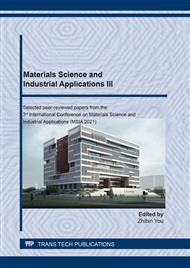p.163
p.172
p.178
p.186
p.195
p.201
p.207
p.213
p.220
Law and Fracture Characteristics of Stress Corrosion Cracking for 7B04 Aluminum Alloy
Abstract:
Two states of aluminum alloy material 7B04 T651 and 7B04 T74 using C-ring specimen were selected to carry out stress corrosion simulation test with different stress levels, corrosion concentrations and time, and the fracture morphology of the crack was observed and analyzed by optical microscope and scanning electron microscope (SEM). The results showed that 7B04-T74 alloy was insensitive to stress corrosion and was not prone to stress corrosion cracking under constant tensile stress lower than 432MPa; The stress corrosion cracking time of 7B04 T651 alloy under three different concentrations has no significant difference, and the stress corrosion cracking occurs within 7 days under the stress of 180MPa-432MPa. The time of stress corrosion cracking increased with the decrease of stress. Stress corrosion cracking (SCC) was very sensitive to Cl element, and it was also easy to produce SCC when the concentration of corrosive medium was low, the threshold value of corrosion cracking was about 108 MPa. SEM and EDS analysis showed that the fracture surface was intergranular, mud-like corrosion products, and secondary cracks. At the same time, the matrix grain boundaries were weakened by Cl element.
Info:
Periodical:
Pages:
207-212
Citation:
Online since:
May 2021
Authors:
Price:
Сopyright:
© 2021 Trans Tech Publications Ltd. All Rights Reserved
Share:
Citation:


